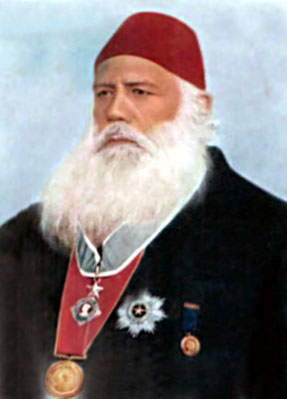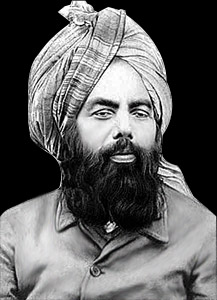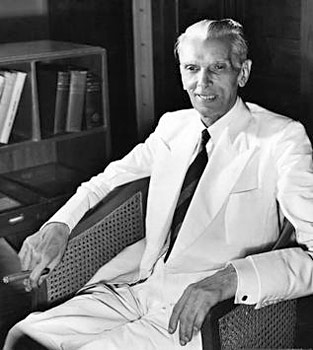 The death of Aurangzeb led to rapid crumbling of the Mughal Empire. Even during his rule Hindu communities like the Marathas and Jats, as well as the Sikhs, had become a challenge to Muslim power. After his death, these elements, especially the Marathas, overwhelmed the Mughal Empire; they threatened and largely destroyed the Muslim economic and political supremacy. There was no Muslim power in the subcontinent which could face this challenge or overcome it. It was at this stage that the Islamic revivalism took the shape of a religio-political movement.
The death of Aurangzeb led to rapid crumbling of the Mughal Empire. Even during his rule Hindu communities like the Marathas and Jats, as well as the Sikhs, had become a challenge to Muslim power. After his death, these elements, especially the Marathas, overwhelmed the Mughal Empire; they threatened and largely destroyed the Muslim economic and political supremacy. There was no Muslim power in the subcontinent which could face this challenge or overcome it. It was at this stage that the Islamic revivalism took the shape of a religio-political movement.
At the pre-modernist stage of Islamic theologi¬cal thinking, that is, in the first half of the eighteenth century the emphasis in the writings of Shah Wall-Allah, a theologian and his well-known Arab contemporary Muhammad Ibn Abd-al-Wahhab, the founder of the Wahhabi Movement in Neja, was on fundamentalism. This meant either a rejection or a symbiosis of the dogmas of various schools of jurisprudence and their replacement by a direct re¬ference to the Quran or what was generally regarded as authentic prophetic tradition. Wall-Allah especially rejected customs and beliefs borrowed from popular Hinduism, or customs and cere¬monies analogically developed and thinly Islamized.
Both Wall-Allah and Muhammad Ibn Abd-al-Wahhab had a sense of mission and considered themselves as reformers or renovators of Muslim society. His political thought achieved results only after two generations. The impact of his religious and political thought was momentous in the second generation after him on the group of religious reformers referred to as Mujahidin (holy warriors) or as the followers of Tariqa-i Muhamadiyya, re¬ferred to, in the British records and writings as the "Wahabis". In subsequent generations, especially after the Sepoy Mutiny (1857-58), his religious rather than his political thoughts influenced every school of Islamic revivalism: the modernism of Sayyid Ahmad Khan and the Aligarh Movement, the traditionalist theologians of the Deoband School, and the neo-traditionalist followers of Muhammad"s traditions.
An almost independent offshoot of Barelwi"s movement was organized in West Bengal by Mir Nishar Ali (1782-1831), popularly known as Titu Mir. His organisational work among the Muslim peasants led to the opposition of Hindu landlords, powerful since the Permanent Settlement of 1793, and British indigo planters. Some Hindu landlords imposed a beard-tax on his followers and persecuted them in other ways. Titu Mir"s organization and his movement were not really as militant or revolu¬tionary as the British records make out; only during the last year of his life was there confrontation between him and the British police. About the same time, further to the east in Bengal, there spread another fundamentalist reformist movement known as the Fara Sidi because of its emphasis on the Islamic pillars of faith. Titu Mir and the Fara Sidis came in conflict with Hindu landlords and British indigo planters and eventu¬ally with the British administration in Bengal. The main difference between the two movements is that whereas the Fara Sidis suspended Friday and Id prayers, thinking of, if not proclaim¬ing, India under the British as dar al-harb (enemy territory) where these prayers are not required, Titu Mir did not do so.
The Fara Sidi movement shows the influence of Arab Wahhabism and little acquaintance with the general theological thought of Shah Wall-Allah. The movement he started affirmed strongly the unity of God and aimed at the eradication of social in¬novations current among the Muslims of West Bengal, many of them borrowed from Hinduism. Though Shariat-Allah"s movement clashed with the interests of the landed gentry of Bengal and he was suspected and persecuted, it remained under him religious and social rather than political. Under his son Dudu Miyan, from 1840 onwards, it became revolutionary. Dudu Miyan built it into a hierarchi¬cal organization rising from the village to the provincial level with a khalifa (authorized deputy) at each level. After Dudu Miyan"s death in 1862 it survived merely as a religious movement without any political overtones.
 The main traditional Muslim opposition to the Fara Sidi movement came from the Taayyuni movement led by Karamat All Jawnpuri and deriving its inspiration from the religious thought of Shah Wall-Allah. The direct conflict between the Fara Sidis and the Taayyunis began about 1839 and lasted for nearly two decades. The Mutiny of 1857-1858 is the watershed which divides the earlier pre-modernist fundamentalist movements from the modernist, the reformist, and even the traditional movements of modern times.
The main traditional Muslim opposition to the Fara Sidi movement came from the Taayyuni movement led by Karamat All Jawnpuri and deriving its inspiration from the religious thought of Shah Wall-Allah. The direct conflict between the Fara Sidis and the Taayyunis began about 1839 and lasted for nearly two decades. The Mutiny of 1857-1858 is the watershed which divides the earlier pre-modernist fundamentalist movements from the modernist, the reformist, and even the traditional movements of modern times.
The Mutiny shattered the fabric of Muslim upper classes in and around Delhi, though not perhaps to the same extent in the Punjab and Avadh. The prolonged Muslim confrontation with the East India Company in northern India had failed everywhere from the north¬west frontier to Bengal. A change in the entire political outlook was as neces¬sary as recognition of the need for adjustment with the new age of Western domination and Western intellectual outlook. Sayyid Ahmad Khan"s pro¬gramme of reform and adjustment was threefold: educational, religious, and political. His educational programme emphasized from the outset the advantages of the use of English as the medium of instruction. In 1864 he founded a modern school at Ghazipur. In 1868 he promoted the formation of education committees in several districts, to initiate modern education among the Muslims.
Sayyid Ahmad Khan"s political activity began with the propagation of the view that it was futile to challenge the British role in India, that it was to be accepted as a reality, and as such the Muslim community should adjust itself to a modus vivendi with it. This should take the form of a staunch loyalty and a support for pax Britannica under which the Indo-Muslim community could transform itself and come to terms with the new age. In the beginning this loyalism was in conflict with emerging Hindu nationalism. The Urdu-Hindi controversy made Sayyid Ahmad Khan doubtful of the community of Hindu and Muslim interests, in the first instance. Alliance with the Hindus against the British could only lead to the loss of the British patronage and its substitution by the exploitation and subjugation of the Muslims by the over¬whelming Hindu majority. Thus, began modern Muslim political separatism in India.
Another interesting, though strictly apolitical, religious movement dates from the same period. This was the Ahmadi movement founded by Mirza Ghulam Ahmad of Qadiyan (1839-1908) who began his work as a defender of Islam against the polemics of the Arya Samaj and the Christian missionaries. In 1889 he claimed to be Masih (Messiah) and Mahaf, and later also to be an incarnation of the Hindu god Lord Krishna as well as Jesus returned to earth. The movement was really a heresy well within the bounds of Islam, as Ghulam Ahmad, though he called himself a minor prophet, regarded Muhammad as the true and great prophet whom he followed. In social morals the Ahmadi movement has been very conservative, adhering to polygamy, veiling of women, and the classical rules of divorce. The Ahmadis have their own mosques and do not pray with other Muslims. A split occurred in the movement in 1914 and it came to be divided in two groups: the Qadiyani which does, and the Lahori which does not believe in the prophet hood of Mirza Ghulam Ahmad. Both groups have produced an extensive religious literature in Urdu, English, and other languages; and the Qadiyani Ahmadis have been for several decades very busy in the propagation of their form of Islam in Africa with considerable success. They have also missionary centres in several cities in the West.
The later half of the nineteenth and the early twentieth centuries also saw an orthodox revival, which was as much a reaction against the "naturalist" modernism of Sayyid Ahmad Khan and the heretical messianism of the Ahmadi Movement as an assertion in its own right of the traditional Islam.
The traditional revival was spearheaded by the seminary at Deoband, founded in 1867 by theologians of the School of Wall-Allah, the most pro¬minent among whom was Muhammad Qasim Nanotawl who also took a prominent part in counter-polemics against the Christian missionaries and the Arya Samajists. The principal objectives of the seminary at Deoband were to re-establish contact between the theologians and the educated Muslim middle classes, and to revive the study of Muslim religious and scholastic sciences. As a religious university Deoband soon became an honoured institution, not only in Muslim India but also in the world of Islam at large, and had a reputation second only to that of Al-Azhar in Cairo.
A school less conservative than Deoband and more responsive to the de¬mands of the modern age was the Nadwat al-ulama, founded in 1894 at Lucknow by the historian Shibli Numani and other scholars. The school aimed to offer an enlightened interpretation of religion in order to fight the trends of agnosticism and atheism which had followed the advent of modern Western education. One of the side-growths of this school was a publishing institution at Azamgarh which made a valuable contribution to Indo-Islamic studies from a liberal Muslim point of view.
 The third famous traditional school is the much older one at Farangi Mahal in Lucknow. Its fame rests principally on evolving the "Nizamiyya" syllabus which was followed by most religious or communal Muslim schools all over India. Unlike the two other schools, the one at Farangi Mahal accepted Sufism as a valid experience and a valid field of study.
The third famous traditional school is the much older one at Farangi Mahal in Lucknow. Its fame rests principally on evolving the "Nizamiyya" syllabus which was followed by most religious or communal Muslim schools all over India. Unlike the two other schools, the one at Farangi Mahal accepted Sufism as a valid experience and a valid field of study.
Comparable and complementary to the religious revivalist movements was the political revivalist movement from the 1880"s onwards. This was essenti¬ally a movement of political separatism initiated, as we have seen, by Sayyid Ahmad Khan. The political instinct of the Indo-Muslim elite was to partici¬pate in and develop this movement. In 1906, a delegation of Muslim leader¬ship, including Sayyid Ahmad Khan"s successor at Alfgarh, Muhsin al-Mulk, as well as Agha Khan III met the viceroy, Lord Minto, and pressed the two Muslim demands. The Muslim party, called the Muslim League, was founded in the same year, and became the first platform of Muslim political interests. Bengal was partitioned in 1905 by the viceroy, Lord Curzon, a move which was advantageous econo¬mically and politically to the Muslims of East Bengal.
The Partition of Bengal was annulled in 1911 under strong Hindu pressure. Muslim leaders realized the instability of British patronage and the Muslim League came to terms with the Indian National Congress in an understanding that they would face the British power jointly. In 1930 the famous poet and thinker Muhammad Iqbal suggested the idea of a separate Muslim state in the north-west. His view was that the stable political future of the Hindus and the Muslims demanded a parting of the ways. The name "Pakistan" was given to the Muslim state thus conceived by him, by a group of Indian Muslim students, most prominent among whom was Chaudhari Rahmat Ali.
In 1937 there was a possibility of the realignment of the Indian National Congress and the Muslim League which was spurned by the leaders of the Congress. The Muslim League from then onwards became the chief forum of Muslim opposition to the Congress. In 1940 in the `Pakistan Resolution` the League committed itself to the concept of Pakistan. This concept was con¬ceded in various degrees by a British Cabinet delegation led by Sir Stafford Cripps in 1942, by the depressed class leader B. R. Ambedkar, and by the Congress leader C. Rajagopalachari. In 1944 there were even discussions between Muhammad Ali Jinnah and Mahatma Gandhi on the question of Pakistan. As late as 1946 a compromise which could have resulted in a united India was possible, when the Muslim leader Jinnah accepted the British Cabinet Mission"s concept of a union of India divided into three sub-federations, of which Group A was to consist of provinces with Hindu majority, Group B consisted of provinces in the north¬west with a substantial Muslim majority, and Group C comprised provinces in the east with a marginal Muslim majority. Once again the ambivalence and lack of political foresight on the part of the Congress leadership led to the loss of this opportunity. Jinnah withdrew the Muslim League"s acceptance of the Cabinet Mission"s plan. Gradually the Indian leaders, first Sardar Patel, then Nehru, and finally Gandhi were convinced by Lord Mountbatten that Pakistan was the only solution of the political problems of India. In August 1947 the British power withdrew from India and the modern states of India and Pakistan came into being.



















